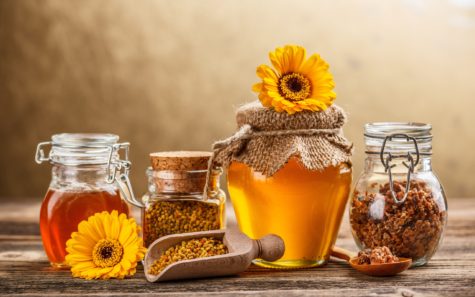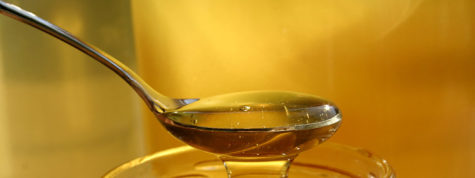Sweeteners
Cooking With Honey
As many cooks have found, honey does more than sweeten and nourish – it adds its subtle depth, body, and mellow flavor to any dish in which it is used. Bakers have long relied upon honey as a necessary ingredient in all their tastiest products, not only for the flavor and color it adds, but because honey assures a moist and tender texture in all breads, cakes, and other baked goods.
Honey can be used in any recipe that calls for an all-purpose sweetener. Here are a few suggestions for the best possible results in cooking with honey.
- When substituting honey for sugar in your favorite recipes, use equal amounts of honey for sugar, up to one cup. Then, reduce the total amount of other liquids by 1/4 cup for every cup of honey used.
- When baking with honey, lower the oven temperature about 25 to 30 degrees F, to prevent over-browning.
- When measuring honey, first coat the measuring utensil with a small amount of oil, otherwise, the honey will tend to stick to the measuring cup or spoon.
- Store honey at room temperature rather than in the refrigerator. Keep it tightly covered and in a dry place.
- Use 1/4 teaspoon of soda for each cup of honey in baking. This will neutralize honey’s natural acidity.
- If honey granulates, place its container in hot water until the honey is once again liquid.
- Foods, and especially baked goods, sweetened with honey will tend to taste their best if served the day after they are baked.
- Honey, because it is hygroscopic, tends to keep foods moist and tender. Therefore, if you are baking goodies for kids away at school, overseas servicemen, or friends out of town, bake with honey to insure freshness.
From: The Honey Cookbook
Varieties of Honey
The real beauty of honey, especially in comparison with other sweeteners, is its many types and their differences. The personality of any honey depends entirely upon which flowers or crops are in the foraging area of the bee colony. About 100 plants are known to provide over 90% of the nectar for honey, although there are thousands of plants that produce nectar. In America, honeybees depend mostly upon fields of clover, alfalfa, cotton, soybeans, and citrus trees, as well as asters, dandelions, goldenrod and sage.
Honey Varieties:
Clover Honey: probably the most popular honey, commands a premium price because of its white to light amber color and mild aromatic flavor.
Alfalfa Honey: is also light in color, with a pleasingly mild aroma and flavor. Because it granulates slowly, it makes excellent chunk, comb, and section honey. It is very often blended with the darker, stronger honeys.
Citrus Honey: also known as Orange Blossom Honey, is very light in color with a distinct flavor, if it is pure. Most citrus honey is a combination of the nectar from oranges, lemons, limes, and grapefruit, as these so often grow in the same area.
Cotton Honey: compares with any honey of the finest quality, and is light amber in color, with a mild flavor.
Soybean Honey: is also light and mild. Its popularity is increasing with the rise in popularity of soybeans as a cash crop.
Buckwheat Honey: is becoming more and more rare in the US, although there are people who would go to any expense to get this honey, because of its distinctive, strong flavor and lovely dark color.
Aster Honey: varies from the light and mild variety of honey, to honey that is dark and distinctive.
Basswood or Linden Honey: which is water white with a very distinct flavor is also becoming rare in the US because basswood forests are declining.
Goldenrod Honey: is very thick and heavy, with a deep golden color. It also granulates quickly, so is very often sold to bakeries.
Dandelion Honey: varies from bright yellow to amber in color, although its flavor and aroma are very strong. It is usually sold to bakeries, as it granulates very quickly.
Sage Honey: also known as California Honey, is premium honey because it is beautifully white with a marvelous flavor, and will not granulate.
Gallberry Honey: is very light with a pleasant taste.
Maple Honey: The maple tree produces a pale amber honey known for its fine granulation – a plus for retailers of “creamed honey.”
Tupelo Honey: a light amber honey from the sour gum tree is preferred by some honey wholesalers because it does not granulate.
Eucalyptus Honey: a very heavy, amber-toned honey.
Tamarisk Honey: is a dark brown with a minty aroma.
Other plants that produce honey with a mild flavor and pleasing aroma include the lima bean, the cranberry and the palmetto. Apple, plum, and cherry trees all produce a light-colored honey with a superb flavor and aroma. Blackberry nectar produces a light honey similar to clover honey.
Source: The Honey Cookbook




